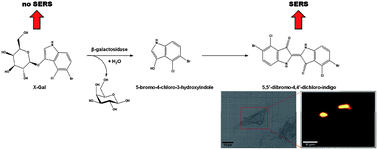
Analysis of intracellular enzyme activity by SERS
Enzymatic activity in cells has been revealed by surface enhanced Raman scattering (SERRS) spectroscopic studies, according to new research led by Duncan Graham at the University of Strathclyde.
X-Gal, a SERRS inactive precursor and a common marker for galactosidase enzymes, was introduced to macrophage cells along with metal nanoparticles. On incubation, enzymatic activity of galactosidase on X-Gal produces a SERRS active trans-alkene dimerised product. This product adsorbs onto the delivered citrate capped gold nanoparticles producing a distinctive SERRS signal. Using SERRS mapping to evaluate the formation of this product, enzyme activity was assessed, not only across a cell population, but also at sub-cellular levels. The authors note that the SERRS activity in this study may not reflect the only sites of galactosidase activity, but rather the sites where both galactosidase and the nanoparticles are co-located. Nevertheless, approaches towards sub-cellular analysis of enzyme activity are important.
Advances in targeted nanoparticle uptake combined with the multiplexing capability of SERRS make this an interesting approach to sub-cellular studies of biochemical activity.
To read the full article, please click on the link below. This paper will be free to read until October 18th.
Analysis of intracellular enzyme activity by surface enhanced Raman scattering
Ross Stevenson, Sarah McAughtrie, Laura Senior, Robert J. Stokes, Helen McGachy, Laurence Tetley, Paola Nativo, James M. Brewer, James Alexander, Karen Faulds and Duncan Graham
Analyst, 2013, Advance Article
DOI: 10.1039/C3AN00729D










